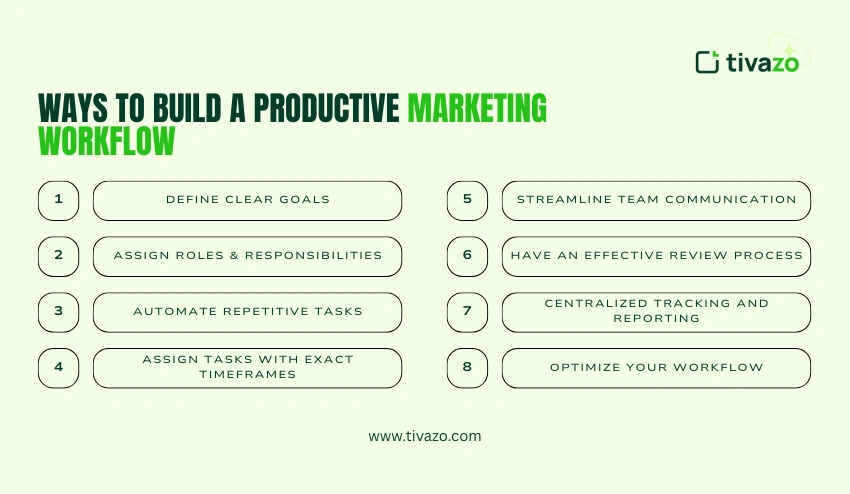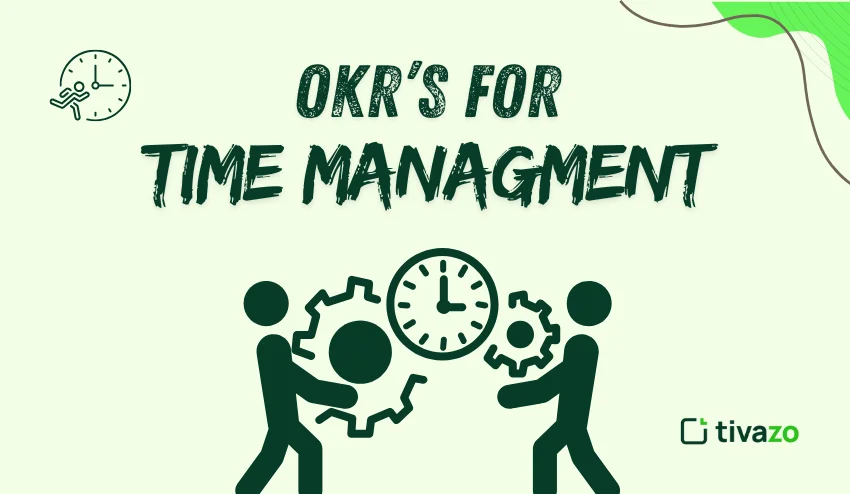Marketing teams typically have multiple campaigns, content pieces, and deadlines to juggle at a time. Things can fall through the cracks easily, and last-minute rushes can quickly become the norm. Constant project changes and shifting goals have the ability to make marketing life more hectic. That’s why having efficient marketing workflow management is so important. The organization combats the chaos and gets work done without last-minute rushes.
In this article, we’ll explore what a marketing workflow is, how to build an effective one for your team, and why it’s key to awesome marketing results.
Understanding a Marketing Workflow
Simply put, a marketing workflow is a structured sequence of tasks that guides a team from planning and content creation to campaign launch and performance tracking. Think of it like a playbook for your team. It outlines who does what, when, and how, ensuring everyone stays aligned, deadlines are met, and nothing falls through the cracks.
How to Build a Productive Marketing Workflow
Building a productive marketing workflow means more than just organizing tasks: it’s about designing a system supporting focus, clarity, and measurable progress. The steps below will help you turn scattered efforts into a streamlined process that works for your team, not against it.

With clear goals and team roles in place, the next step is choosing the right tools to streamline repetitive work.
1. Define Clear Goals and Strategic Focus Areas
Every productive marketing workflow starts with clarity. Before assigning tasks or choosing tools, align your team around strategic objectives. What does success look like for this campaign or initiative? Are you focused on lead generation, brand awareness, customer retention, or something else entirely?
For example, a team goal might be to increase qualified leads by 20% in Q3 or drive 500 webinar sign-ups within two weeks. These targets guide your campaign planning, dictate timelines, and help prioritize tasks.
It’s also critical to define which channels will carry the weight, including email, social, SEO, and paid media, and how they support one another. Without shared direction, even a well-organized workflow can spin its wheels.
2. Assign Roles, Responsibilities, and Decision-Making Authority
Once goals are in place, the next step is assigning ownership. Who’s doing what, and who has final say? A good marketing workflow clearly maps out roles across strategy, content, design, review, and launch phases. Without this clarity, feedback loops multiply and deadlines slip.
Ask questions like:
- Who owns campaign strategy and messaging?
- Who’s responsible for writing, design, and asset production?
- Who reviews and approves final deliverables?
- Who publishes or launches the campaign?
Beyond task assignments, define escalation paths and decision-makers. Knowing who signs off on what reduces confusion and keeps the process moving. This level of role clarity is especially crucial in remote or cross-functional teams, where misalignment can easily go unnoticed until deadlines are missed. As noted by the team at Martal Group, clarity in workflow isn’t just about assigning ownership — it’s about preventing bottlenecks that can stall campaigns and derail timelines. Their experience shows that even modest improvements in decision-making processes can free up hours each week and keep marketing teams aligned with broader sales goals.
3. Automate Repetitive Tasks & Use the Right Tools
Marketing workflow automation significantly speeds up processes and optimizes your workflows. Identify time-consuming or error-prone tasks: there’s likely a tool to handle them..
For example, reporting data really eats up time. Instead of settling into manually assembling metrics, you can use a tool like Google’s Looker Studio to create real-time dashboards and interactive reports out of disparate sources of data. It saves time and delivers easy, real-time reporting for your marketing campaigns.
For SEO campaigns, you can incorporate an SEO platform’s API to bring data into your workflow directly. SEO tools such as SE Ranking offer APIs you can use to automatically pull in keyword rankings, website health, and backlink reports. Thanks to this, you can monitor SEO performance without constantly having to check manually.
Equally, you can schedule email campaigns, social media posting, or lead assignments with specialized software or services such as Zapier. For content-heavy campaigns, an AI script generator can also be used to draft video scripts, ad copy, or social captions, helping teams save time while maintaining consistency in messaging.
4. Assign Tasks with Exact Timeframes
Once roles and tools are set, break the project into tasks and assign each one an owner with a clear deadline. Defining who does what by when keeps the team aligned and the workflow on track.
5. Streamline Team Communication & File Sharing
Marketing projects involve constant information exchange—drafts, briefs, feedback, and approvals. Without a central system, communication gets lost in endless email threads and scattered files.
To stay productive, centralize how your team shares files and collaborates. This avoids confusion over versions and ensures everyone has access to the latest updates. Use secure tools, especially when handling confidential materials.
Establish clear team rituals too: define one main channel for daily questions (like Slack or Teams) and standardize the feedback process through comments or a dedicated review tool. Streamlined communication keeps work flowing and errors minimal.
6. Have an Effective Review Process
An effective review process keeps work on track and up to standard. Make expectations clear, reviewers should know what to assess, and creators should know when to submit. Limit review cycles to avoid delays, and set reasonable turnaround times for feedback.
When structured well, this phase ensures quality without slowing progress.
7. Centralized Tracking and Reporting
A productive workflow relies on a single source of truth. Instead of scattering metrics across files and tools, consolidate performance data, task status, and campaign insights in one place, be it a marketing dashboard, project tracker, or even a well-maintained Google Sheet.
Most teams use project management tools that integrate with analytics platforms, enabling side-by-side views of progress and results. The format matters less than the function: your system should be organized, transparent, and easily accessible to everyone who needs it.
8. Continuously Optimize Your Workflow
Use workflow insights to trim the excess, have fewer status meetings, smarter approval reminders, and minimal administrative overhead. The workflow should accelerate execution, not become a burden.
Keep an eye on how much time is spent managing the process versus doing actual marketing work. If tracking or meetings start to eat into productivity, simplify them. Stay open to adopting new tools that reduce friction, especially if one can replace several others.
As your team evolves or strategy shifts, revisit and refine roles, steps, and tools to keep the system agile and aligned.
Why Marketing Workflow Automation Matters
Here are three key reasons why an effective marketing workflow process is essential:
- Keeps the team aligned. A structured workflow gives everyone a shared game plan. With clear task ownership and timelines, team members stay in sync and work toward common goals.
- Enables strategic execution. Defined priorities and dependencies help teams work proactively—not reactively. This leads to consistency, better planning (like regular content calendars), and stronger results.
- Boosts efficiency and ROI. A streamlined process removes bottlenecks and makes progress easy to track. It also surfaces issues early, so they can be resolved without derailing campaigns.

In short, marketing workflow automation helps your team stay focused on real impact—not just busywork.
Practical Marketing Workflow Examples
Let’s break down a few real-life marketing workflow examples so you can see how these systems work in action.
1. Social Media Marketing Workflow
Here’s what a typical social media marketing workflow looks like, step by step:
- Start with the goal. Define the campaign objective, like boosting brand awareness or driving traffic.
- Brainstorm campaign ideas supporting your goal, then outline your content theme.
- Plan your content calendar. Decide what to post, when, and where (e.g., LinkedIn, Instagram, X).
- Create the content. Writers draft captions or posts; designers produce supporting visuals, images, videos, GIFs, etc.
- Get approvals. A manager or client reviews the posts to ensure everything aligns with brand guidelines and goals.
- Schedule and publish. Use a social media management tool to queue everything up, or post manually.
- Monitor results. Track key metrics like reach, engagement, click-throughs, and conversions to measure performance.
This kind of structured workflow helps avoid last-minute chaos, keeps roles clear, and ensures your campaign stays on track from idea to execution.
2. Email Marketing Workflow
Here’s how a typical email marketing workflow unfolds:
- Segment your audience. Start by deciding who you’re writing to. Use criteria like customer type, interests, or past behavior to group your contacts for better targeting. Before moving forward, use a tool like DeBounce to clean and validate your email list, ensuring you’re reaching real, active inboxes.
- Define the campaign’s purpose. Is it a welcome series, a monthly newsletter, or a promo for lapsed customers? Clarify the goal upfront.
- Plan the content and layout. Outline the main message, call to action, and visual structure of your email.
- Create the assets. Write the copy and design any visuals, banners, buttons, or product images, bringing the message to life.
- Send a test email. Always test before launching. It’s the easiest way to catch formatting issues or typos before your message hits inboxes. Before you hit ‘send,’ consider running an email deliverability test to ensure your emails reach the inbox—not just the server.
- Launch and monitor. Once everything looks good, send your email to the full list. Then track open rates, clicks, and conversions to measure success. To maintain data accuracy, also consider using fake signup protection to prevent invalid or spam entries from affecting your campaign performance
A solid workflow like this helps ensure your campaigns land well in verified email addresses, email campaigns land well, look great, and actually deliver results.
3. SEO Marketing Workflow
An effective SEO marketing workflow helps your team improve search visibility in a structured, repeatable way. Here’s how it typically works:
- Start with keyword research. Use SEO tools to find the terms your target audience is actually searching for, look for a balance of relevance and search volume. These keywords will shape your content strategy.
- Create content around those keywords. Once you’ve built a solid list, start producing blog posts, landing pages, or other assets that answer search intent clearly and help users.
- Optimize for on-page SEO. Place keywords (and natural variations) in the page title, headings, meta description, and URL—but keep it human-friendly. Content should be well-written, helpful, and easy to read.
- Support it with off-page SEO. Promote your new content through backlinks, listings, or partnerships. Outreach to relevant websites or share content strategically to encourage links and traffic.
- Monitor performance. Once published, track keyword rankings, organic traffic, and engagement. Use this data to see what’s working and where to adjust.
- Refine and update regularly. SEO is never “done.” Revisit underperforming pages, update outdated content, and double down on top performers.
This kind of workflow keeps your SEO efforts consistent, measurable, and aligned with business goals, rather than a scattershot mix of random optimizations.
Why Marketing Workflow Management Drives Results
Marketing workflow management is more than organization; it’s the foundation of high-performing marketing teams. It transforms scattered tasks into a clear, repeatable process that keeps everyone aligned and accountable.
Without a defined workflow, teams face delays, miscommunication, and missed opportunities. With one, they gain clarity, speed, and the structure needed to launch effective campaigns.

Don’t wait until a missed deadline or a chaotic launch forces change. Build your workflow now and let your marketing finally run like a team sport.
Conclusion
A well-designed marketing workflow transforms chaos into clarity, guiding teams from strategy and content creation to campaign launch and performance tracking. By defining goals, assigning clear roles, leveraging automation, and centralizing communication and reporting, teams can stay aligned, meet deadlines, and optimize results. Whether managing social media, email, or SEO campaigns, a structured workflow reduces bottlenecks, ensures quality, and maximizes ROI, turning scattered tasks into a repeatable, efficient process that drives measurable marketing success.




